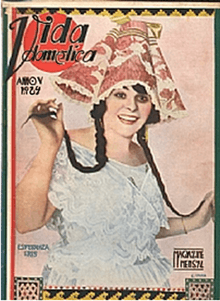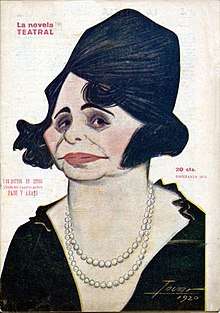Esperanza Iris
María Esperanza Bofill Ferrer (30 March 1888 in Villahermosa, Tabasco - 7 November 1962 in Mexico City), better known by her stage name Esperanza Iris, was a Mexican singer, leading lady, and stage actress.

Early life

Born in Villahermosa, Tabasco March 30, 1888,[1] her birth name was María Esperanza Bofill Ferrer, but her stage name was Esperanza Iris.
She began her artistic career in the theater company Austri and Palacioscon in the play Las campanas de Carrión, which lasted for five years. Then in 1902 in the Teatro Principal she participated in La cuarta plana, for which she won the respect of the public. In Brazil she was famous for "La Reina de la Opereta" and “Emperatriz de la Gracia,” and in Spain she was decorated by King Alfonso XIII. Iris went on an international tour to Cuba between 1910 and 1911 with the play La viuda alegre.
Construction of her theater
In 1918 she constructed her own theater, el Gran Teatro Esperanza Iris, built by architect Federico E. Mariscal.[2] It was inaugurated in the presence of President Venustiano Carranza. In 1922 she was declared "Hija Predilecta de México," or "Favorite Daughter of Mexico" and filmed two movies: Mater nostra[3] and Noches de gloria. She organized a choir in the penitentiary Lecumberri when her husband Paco Sierra was a prisoner after an incident in 1952.[4]
Her last theater performance was in the play La viuda alegre. Esperanza Iris died on November 7, 1962 in Mexico City. Her remains were interred in the Panteón Jardín.
Homage
To pay homage to her artistic trajectory in Mexico, the state theater of Tabasco was rechristened Teatro Esperanza Iris. After a period, the theater Iris built in Mexico City went only by "Teatro de la Ciudad," but during the government of Marcelo Ebrard it returned to its original name: Teatro de la Ciudad Esperanza Iris. Mexico City's Historical Center was named a World Heritage Site in 1987 by the United Nation's Educational, Scientific, and Cultural Organization (UNESCO).[5]
See also
References
- Lopez Sanchez, Sergio (2002). "Esperanza Iris. La tiple de hierro (Escritos 1)". INBA Digital.
- Vargas Salguero, Ramon (2005). Federico E. Mariscal. Vida y obra. UNAM. p. 29. ISBN 9703212530.
- Rico, Araceli (1999). El teatro Esperanza Iris. La pasión por las tablas. Plaza y Valdés. p. 124. ISBN 9688566861.
- Cherem, Silvia (2017). Esperanza Iris. La última reina de la opereta en México. Planeta. p. 307. ISBN 9786070741418.
- "Teatro de la Ciudad Esperanza Iris" [City Theatre of Esperanza Iris]. Mexico Es Cultura (in Spanish). Retrieved 24 April 2019.